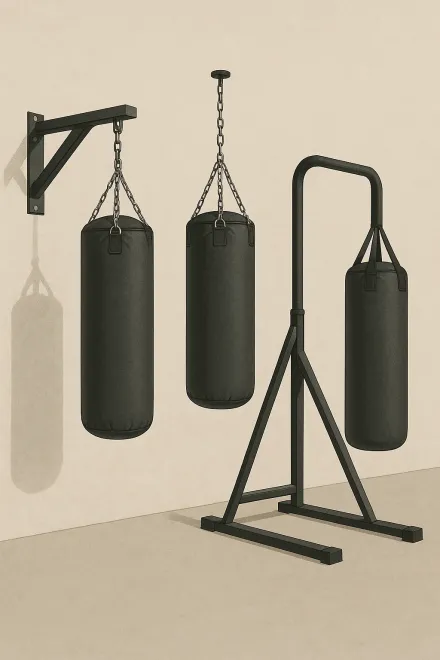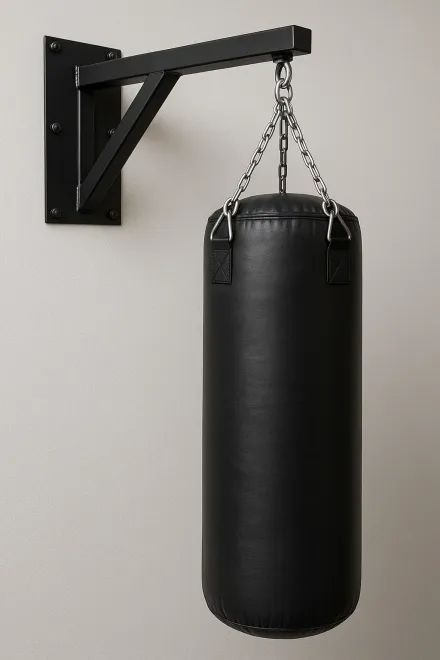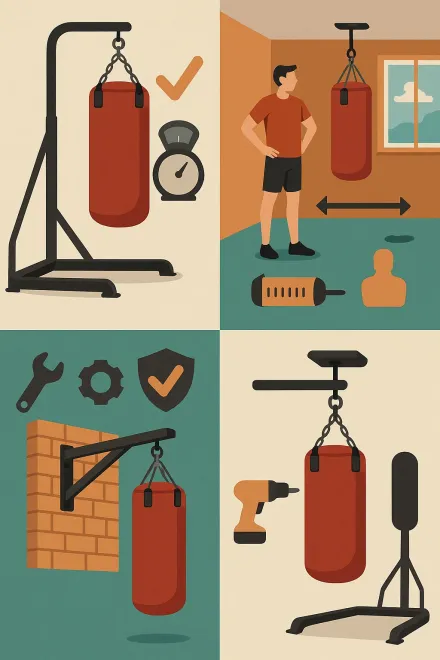Punching bag stands
Punching bag stands are essential for anyone who wants to train safely and efficiently at home or in a gym. A heavy bag needs a strong, stable anchor that can handle impacts, whether installed on a wall, from the ceiling, or via freestanding frames. Choosing the right stand ensures not only the bag's durability but also a more comfortable and safer practice. In this guide, we'll explore the different stand types available, their advantages, how to install them, and practical tips so you can get the most from your training.
See punching bag stands on Amazon
Types of punching bag stands
There are different types of punching bag stands, each designed to suit various spaces, needs, and training styles. The main ones are:
- Wall mounts: They are fixed directly to a solid wall with screws and expansion anchors. They are very secure and take up little space.
- Ceiling mounts: They let you hang the bag from above, giving freedom of movement around the bag and a more natural feel on strikes.
- Freestanding frames: They do not require drilling into walls or ceilings, as they are independent stands. They are usually bulkier, but ideal if you don't want to make holes.
Each option has its pros and cons. The best choice will depend on the bag you have, the space available, and your training style, whether boxing, muay thai, kickboxing, or simply fitness.
Advantages of installing the right stand
Installing a quality stand for your punching bag has multiple advantages. First, it ensures the bag's stability, preventing excessive vibrations that can damage your home's structure or the equipment itself. It also helps prevent accidents, since a weak stand can come loose with continuous use.
Another key benefit is comfort during training. A well-installed stand lets you throw fluid movements and powerful strikes without worrying about the mount's resistance. In addition, many stands include swivel hooks that reduce chain wear and prevent tangles.
Finally, a suitable stand extends your punching bag's lifespan, as it better distributes weight and impacts. This is especially relevant in intensive sessions with punch and kick combinations.


How to choose the ideal hanger
The choice of hanger for a punching bag depends on several factors that are worth analyzing in detail:
- Bag weight: Not all stands support the same load. It is essential to check the maximum permitted weight to avoid accidents.
- Available space: If you have a large area, a freestanding frame can be ideal. In smaller rooms, a wall or ceiling mount is better.
- Materials and strength: Look for stands made of reinforced steel with anti-corrosion finishes if installed outdoors.
- Installation: If you don't want to drill walls, choose a freestanding stand. If you prefer something more discreet, a ceiling mount can be the best option.
Before buying, it is also advisable to read user reviews and compare models based on your specific training needs.
Installation and maintenance of stands
Installing a punching bag stand must follow certain safety recommendations. For wall mounts, it is crucial to fix them to solid walls, preferably concrete or solid brick. They should never be installed on drywall partitions or weak walls. For ceiling mounts, the ideal is to anchor them to wooden joists or metal structures capable of bearing heavy loads.
For freestanding frames, although no drilling is required, it is essential to secure them with counterweights or sand/water bases so they do not move under strikes. Some models even allow height adjustment to suit different training styles.
Maintenance also matters: check screws, hooks, and welds regularly to ensure everything is in good condition. Lubricate swivel hooks if present, and verify that the bag hangs correctly to avoid uneven wear.
A well-installed and well-maintained stand not only extends your equipment's life but also guarantees safer, more effective training.
Practical tips for training with a well-mounted bag
Once your stand is installed, it is time to make the most of your punching bag. Here are some practical tips:
- Warm up before training: Prevent injuries with stretches and mobility work before you start.
- Use proper gloves: Even with a sturdy stand, hitting without protection can injure your hands.
- Work on technique: It's not just about hitting hard, but improving precision, speed, and combinations.
- Vary your training: Alternate endurance, power, and cardio sessions. The bag helps simulate a real fight and train overall conditioning.
- Manage distance: Thanks to a well-placed stand, you can move around the bag and practice slips, entries, and exits.
Also remember to hydrate during the session and respect rest times. With a stable stand, your bag becomes a versatile tool to boost performance in boxing, kickboxing, or fitness.
Frequently asked questions about punching bag stands
Which hanger is best for a heavy punching bag?
If your punching bag weighs over 40 kg, the most advisable option is a wall or ceiling mount anchored to a solid surface such as concrete or strong joists. These offer the greatest safety and stability. Freestanding frames can also work, but you must ensure the model supports that weight and add counterweights for extra stability.
Is it safe to install a stand on drywall?
It is not advisable to install a punching bag stand on drywall. This material is not designed to withstand the bag's weight and repetitive training impacts. Installation should always be on solid walls such as concrete or brick, or on strong joists for ceiling mounts.
What maintenance does a punching bag stand need?
Basic maintenance includes regularly checking screws, hooks, and welds to ensure there is no wear or damage. If the stand has a swivel hook, it is worth lubricating it occasionally to avoid noise and excessive friction. It is also recommended to check that the bag hangs centered and at the correct height for comfortable training.
Is a freestanding stand as sturdy as a wall mount?
Freestanding stands can be very practical because they require no drilling, but in terms of strength and stability, a well-installed wall or ceiling mount is usually safer for intensive training. Even so, there are high-quality freestanding models that support heavy bags, provided they are reinforced with counterweights.
Can a ceiling mount be installed in an apartment?
It depends on the ceiling structure. If the apartment has strong joists or concrete slabs, a ceiling mount is possible. However, it is not recommended for false ceilings or light materials. In those cases, a wall mount or freestanding structure can be a safer alternative.
What is the right height to hang a punching bag?
The correct height depends on your stature and training type. Generally, the top of the bag should be at your head height or slightly above, so your strikes have a realistic range of motion. Adjusting the height also helps avoid shoulder and wrist injuries.
Do I need a chain or can I hang it directly from the hook?
It is best to use chains or straps made for punching bags, as they distribute weight better and reduce stand wear. Hanging the bag directly from the hook can cause damage to both the bag and the stand over time.
